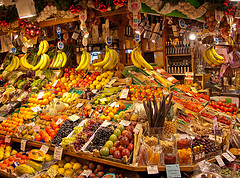 Would you like a side of pesticide with your juicy apple? If you are consuming non-organic apples you might just be getting that. According to the Environmental Working Group, 92% of conventionally grown apples contained 2 or more pesticide residues. So just how dirty is your food?
Would you like a side of pesticide with your juicy apple? If you are consuming non-organic apples you might just be getting that. According to the Environmental Working Group, 92% of conventionally grown apples contained 2 or more pesticide residues. So just how dirty is your food?
That to me is an alarming amount. Not only are pesticides toxic to human health, but they are damaging to the environment. Pesticides were created to kill living organisms such as plants, insects and fungi that can be categorized as “pests.”
The U.S government has linked pesticides to nervous system toxicity, cancer, hormone system disruption and skin, eye and lung irritation! Scary stuff!
Every year the Environment Working Group analyses approximately 100,000 produce reports from the USDA and FDA. They rank them by the likelihood of being consistently contaminated with a significant amount of pesticides at the highest levels.
The great things is all this information is presented in a user-friendly guide on the EWG site. This helps consumers make educated decisions on which fruits and vegetables they want to purchase.
In a perfect world, everyone would be able to afford organic produce, but sadly not everyone can. By not purchasing fruits and vegetables form the “dirty dozen” list, you are significantly lowering your pesticide exposure.
How dirty is your food?
- Apples – Of all the samples of apples tested 99% percent tested positive for pesticides; and they registered the second-highest number of pesticides containing combinations of up to 56 different chemicals.
- Strawberries – One single sample of strawberries, 13 different pesticides were discovered. Gross- I love strawberries.
- Grapes (imported) – A single grape sample contained 15 pesticides
- Celery – A single celery sample was contaminated with 13 different chemicals.
- Peaches – They were found to be the most treated produce containing up to 57 different chemicals; and it was discovered that 85.6 percent of peaches contain 2 or more pesticide residues.
- Spinach – One of the vegetables to retain pesticide combinations.
- Sweet Bell Peppers – Nearly 69.4 of the sweet bell peppers tested contained multiple pesticides and a single sample contained 11 different types of chemicals. Side note, hot bell peppers have been contaminated with 97 different pesticides.
- Nectarines (imported) – Every sample of imported nectarines tested positive for some kind of pesticide and 90.8 percent of them contained 2 or more pesticide residues.
- Cherry Tomatoes – A single sample of cherry tomatoes was contaminated with 13 different chemicals.
- Snap Peas (Imported) – A single sample of snap peas was contaminated with 13 different chemicals.
- Potatoes – The average potato had more pesticides by weight than any other food.
- Cucumbers – Treated with as many as 68% different pesticides.
There’s More…
- Avocados were the cleanest: only 1 percent of avocado samples showed any detectable pesticides.
- Some 89 percent of pineapples, 82 percent of kiwi, 80 percent of papayas, 88 percent of mango and 61 percent of cantaloupe had no residues.
- No single fruit sample from the Clean Fifteen™ tested positive for more than 4 types of pesticides.
- Detecting multiple pesticide residues is extremely rare on Clean Fifteen™ vegetables.
- Only 5.5 percent of Clean 15 samples had two or more pesticides.
- Hot peppers are treated with as many as 97% pesticides, and greens with 67%.
What do you do?
Fruit and veggies that have a non-edible skin can contain less pesticides. Just remember to wash the skin with this veggie wash before peeling or cutting into any fruit or veggie. Just water is not good enough anymore. When you cut into an unwashed fruit or vegetable, whatever was on the skin can contaminate the inside of the produce.
This blog originally appeared on Good Girl Gone Green’s blog here.




